Most indoor flowers love light. Therefore, plants that can exist in low light conditions are worth their weight in gold. That is the bamboo palm. Caring for Hamedoria at home has its own characteristics, but not too complicated.
Material Content:
Species and varieties
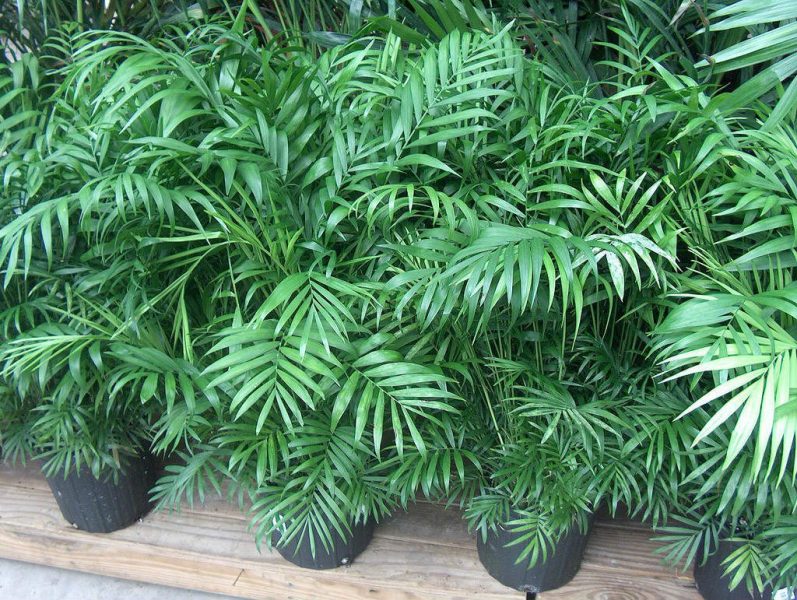
Hamedorea belongs to the palm family. In nature, can be found in the rainforests of South America, Mexico. It grows in the foothills, for which it received another name - Mountain palm. It can grow in the form of a tree or bush, some species - creepers. The height of any of them does not exceed 5 m, in indoor conditions, the Hamedorea palm is much lower, only some species grow to the ceiling. This elegant plant can grow no more than 2 beautiful cirrus leaves in a year. Several trunks can grow from one rhizome, so the bamboo palm often looks like a bush. It grows slowly and reaches its maximum size soon. Hamedorea is able to bloom in the room and even give black fruits, each of which has only one seed, but this will require a male plant, since this palm is dioecious. You can plant plants of different sexes in one pot or put two pots with heterosexual palm trees side by side, then there will be no problems with pollination. In nature it is pollinated by insects. In the room, this role will have to take on the grower. In practice, most gardeners remove peduncles: the flowering of bamboo palm trees greatly depletes the plant.Small flower balls of yellow or reddish color in male specimens are collected in small inflorescences, resemble mimosa, single female flowers, orange in color have an aroma.
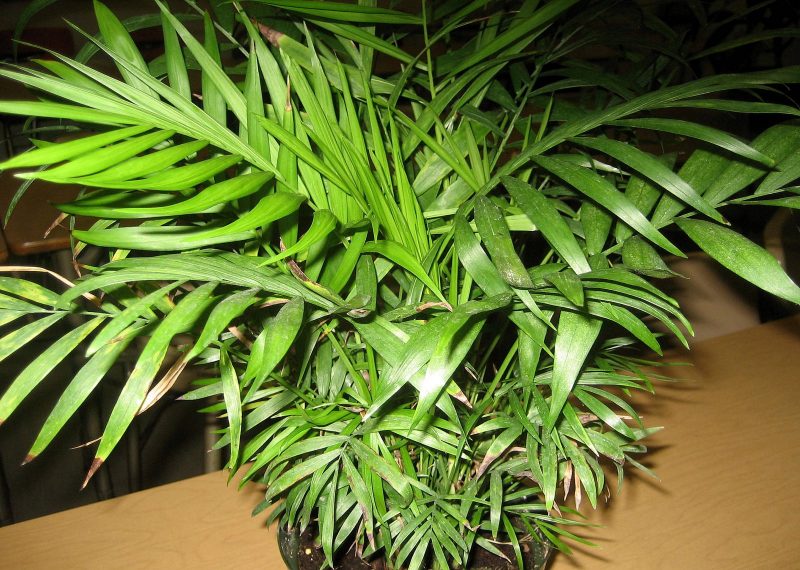
In a room culture of 130 species, only a few are grown.
- Hamedorea graceful, also known under the names of Hamedorea elegans, elegant collinia, beautiful Neantha. The maximum height of the plant is 2 m. From one rhizome, up to 7 stems with a diameter of up to 3.5 cm can grow. Each of them is decorated with arcuate curved branches on long petioles from 40 cm to 1 m long, bearing up to 14 pairs of linear leaves. In their sinuses appear inflorescences of yellow flowers with a pleasant aroma. This type of mountain palm blooms for 3-4 years. Among all types of bamboo palm trees, it is Hamedorea elegans that is the most unpretentious, apparently, for this reason it is so popular among flower growers.
- Hamedorea Bridble - a hybrid based on the previous view. She is no less popular than elegant. They have few differences: the height of the plant is only 1.5 m, the flowers and inflorescences are slightly larger, brighter and more aromatic.
- Hamedorea high. It justifies its name - it can grow up to 3 meters or more. Its stems are more like bamboo than in other species: each leaf that falls off forms a kind of joint on the plant, hence the similarity. The trunks of this palm can be up to 10 or more.
- Hamedorea Plain similar to elegant, but the internodes are longer, and the leaves are thinner and longer, they have a salad color. There are many trunks of this palm. Blooms very late - in the 70th year. Differs in unpretentiousness.
- Hamedorea cascade, which is sometimes called the cat palm. It grows with numerous trunks with thin leaves of dark green color. In culture, it is more capricious than other species.
- Hamedorea stolononosnaya. A low bush palm, giving many thin shoots with medium-sized leaves. It can give air roots, which facilitates its reproduction.
- Hamedorea Ernest-Augustus. Also forms aerial roots, they are located at almost every base of the internode. The shape of the leaf is not similar to that of other types of mountain palm: they are solid, but deeply dissected in the middle, so they look like a heart. These "hearts" can grow up to 60 cm in length, and up to 25 in width.
- Hamedorea metal. Rarely found on sale. The plant is very beautiful due to the dark green foliage, which seems almost black. In the sun, the leaves shine like polished silver. Their shape is heart-shaped, as in the previous species, but smaller in size. The trunk of this palm tree is the only one, with time it lignifies.
Basic growing requirements
In nature, chamedorea grows in the lower tier of the rainforest. There is little light, but this does not prevent the plant from developing normally. Competing with large trees for moisture and nutrition, the palm tree learned to do with a small number of them. What she categorically does not tolerate is damage to the root system, so special care must be taken when transplanting.
It is interesting: bamboo, houseplant, care
Caring for Hamedorea at home
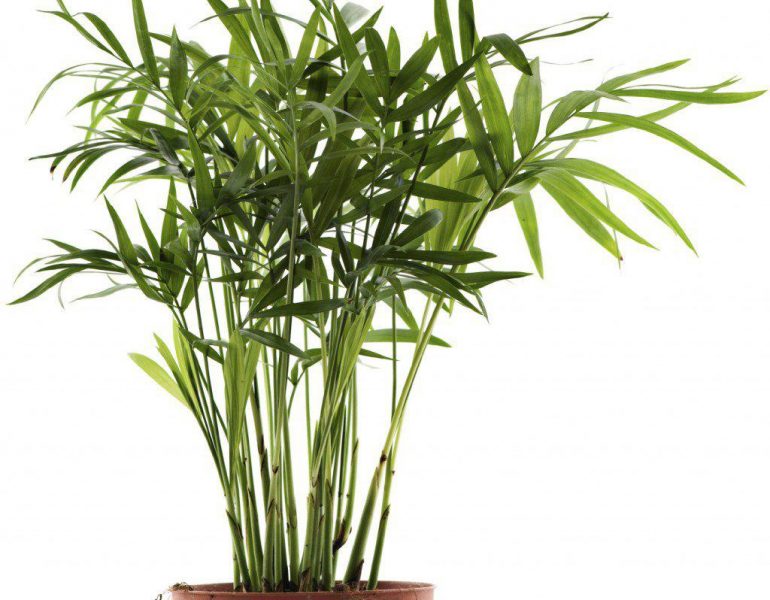
The plant feels best in conditions close to natural. It is surprisingly unpretentious, but it has its own requirements for care, which must be observed in order to achieve maximum decorativeness.
Lighting, temperature, humidity

Different types of light are not the same. Less unpretentious, such as elegant and monochrome, will grow well even on the north window or in the back of the room with southern lighting. More demanding species need to be placed on the east or west window. But any bamboo palm tree cannot exist in direct sunlight. Shading from them in a period of time from 10 to 17 hours is mandatory. In order for the plant to develop evenly and be symmetrical, the pot is turned around its axis once or twice a month, changing its position relative to the light source.Daylight hours at any time of the year should be about half a day.
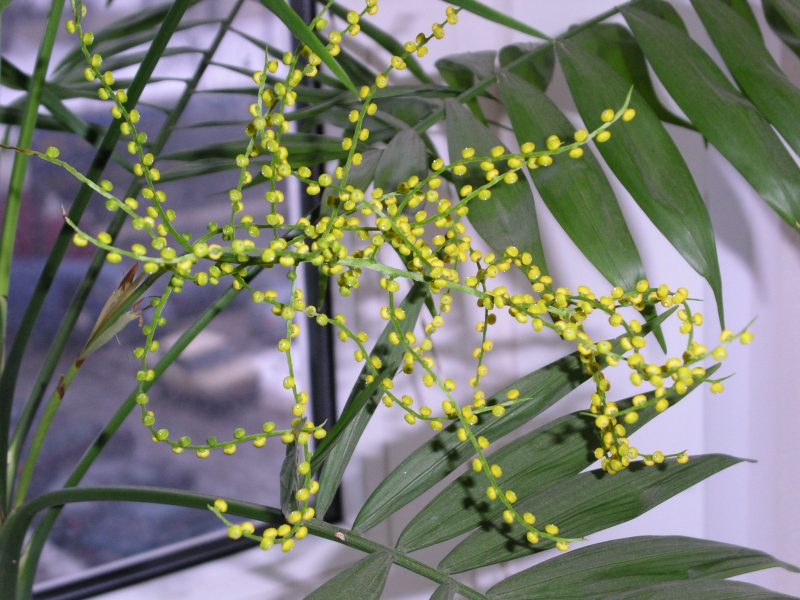
Despite the fact that Hamedoreya is a native of the tropics, she does not tolerate too high a temperature in the room. The most beautiful and spreading specimens grow in greenhouses, where it is cool enough, a lot of air and ambient light. To make your pet comfortable, maintain the temperature in the summer from 22 to 27 degrees, and in the winter within 16-17 degrees, but the temperature drop should be gradual, its sharp jumps can lead to decay of the roots. The cooling of the soil below 16 degrees of heat also leads to this.
At a temperature of 12 degrees Celsius, the plant dies.
He loves fresh air, so you need to ventilate the room at any time of the year, but without a draft, his plant does not tolerate.
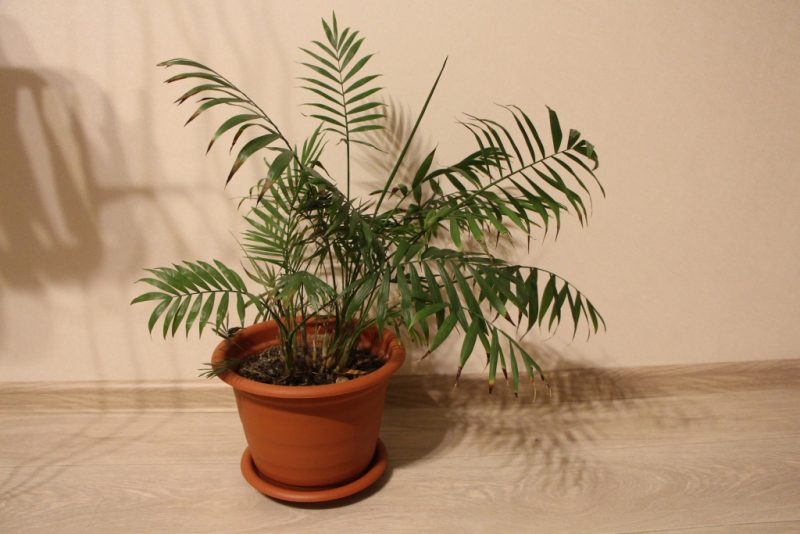
There is always humid air in the rainforest. So it should be in the room in which the mountain palm grows. Below 55% is a critical indicator. Not only will the plant develop poorly, ideal conditions will be created for the reproduction of the spider mite, and it is difficult to get rid of it. For some types of palm trees, it is quite simple to increase the air humidity: it is enough to periodically arrange a warm shower to elegant and one-flowered. For the rest, a set of measures is needed so that the air has the necessary humidity.

- Spraying at least 2-3 times a day with soft water with a temperature slightly above room temperature.
- A humidifier or just cans of hot water next to the flower.
- Wet towel on the heating battery.
- Place the pot on a pallet with moistened moss or expanded clay. The drain hole must be above the water level.
- Steam baths. Put the pot in the bath, and fill the room with steam. Immediately after the procedure, it is impossible to take the pot with a palm tree out of the bath, you need to wait until the temperature is equal to room temperature.
Varieties such as cascade, stolononosnoy and metal require daily wiping of leaves with a damp cloth. In winter, keep the flower pot away from the battery. The number of hygiene procedures is reduced to one per month.
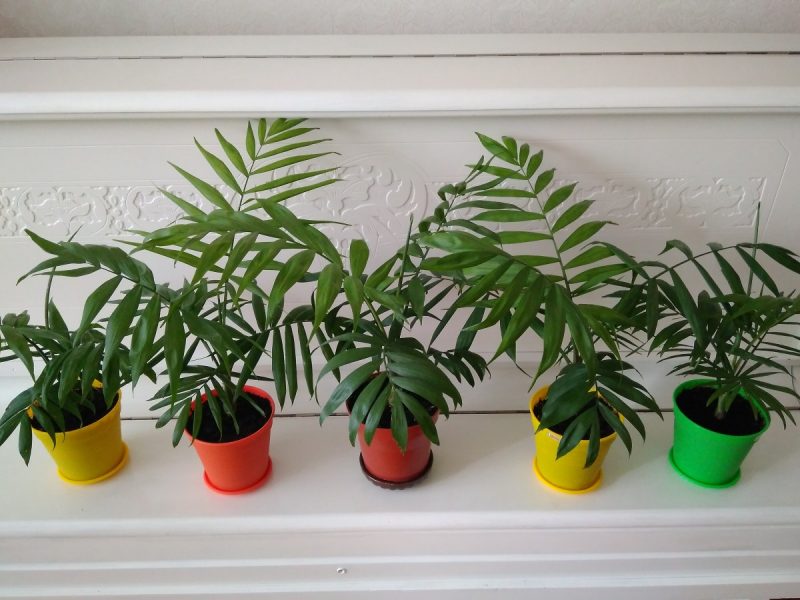
Palm Hamedoreya positive about staying outdoors in the summer. But you can not put it in the sun and where the wind constantly walks. A pot with a plant should also be protected from cold rains.
Watering the Hamedorea

The most difficult thing in caring for a Hamedorea flower is its proper watering. Excessive soil moisture will inevitably cause death if it is constant. It is impossible to give an exact schedule for watering palm trees - each owner has too different growing conditions. There is a criterion that allows you not to make a mistake. From watering to watering, the soil in the pot should dry out at least half the height. The lower the temperature, the stronger it should dry. There is one exception to this rule: the soil at the cascade Hamedorei should always be moist, but not waterlogged. How to check it? You can use a wooden stick, which pierce the soil at the walls to the bottom. It will show how dry the soil is.
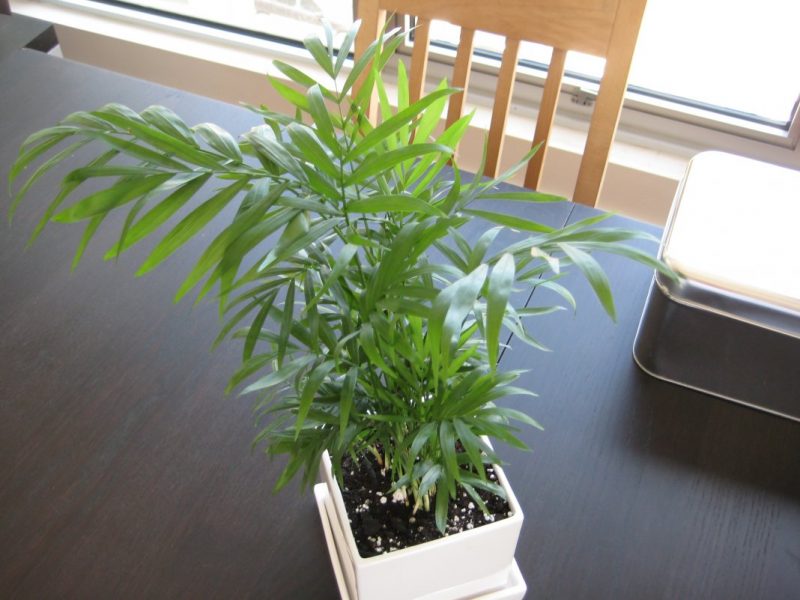
For watering Hamedorei only soft water with a low salt content is needed. Its temperature should be slightly warmer than room temperature - about 30 degrees.
Soil Composition and Pot Selection
The root system grows in depth, it needs not a wide, but deep pot. The soil for the plant requires loose. Air and water must pass through it unhindered. The soil should be slightly acidic, nutritious, contain a lot of humus. You can take the soil for palm trees and dilute it with loosening material: chopped moss sphagnum, chopped wood bark, coconut fiber in a ratio of 5: 2.
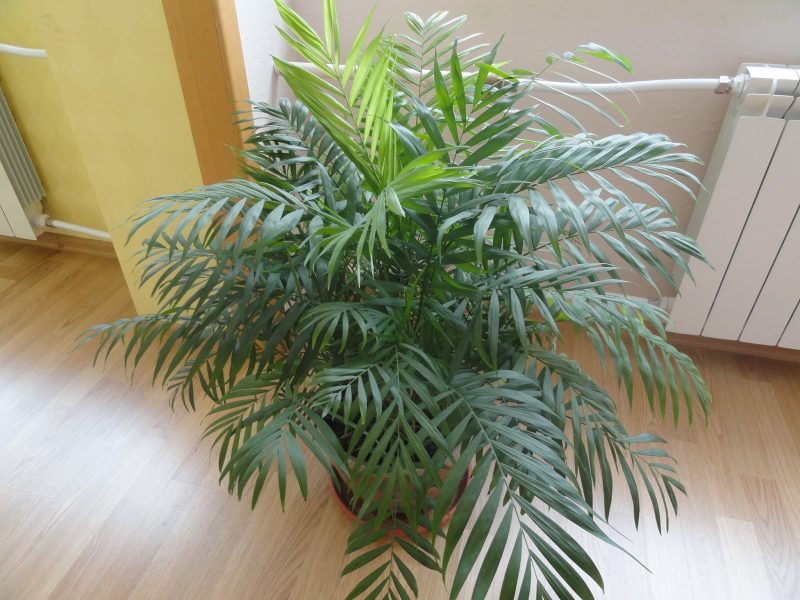
The soil mixture can be composed of the following components:
- turf land - 3 parts;
- humus and universal soil - 2 parts each;
- coarse river sand - 1 part.
You can take in equal shares turf land, peat, humus, vermiculite or perlite.It is important that all components that may become a source of infection or a pest carrier are sterilized.
Fertilizer application
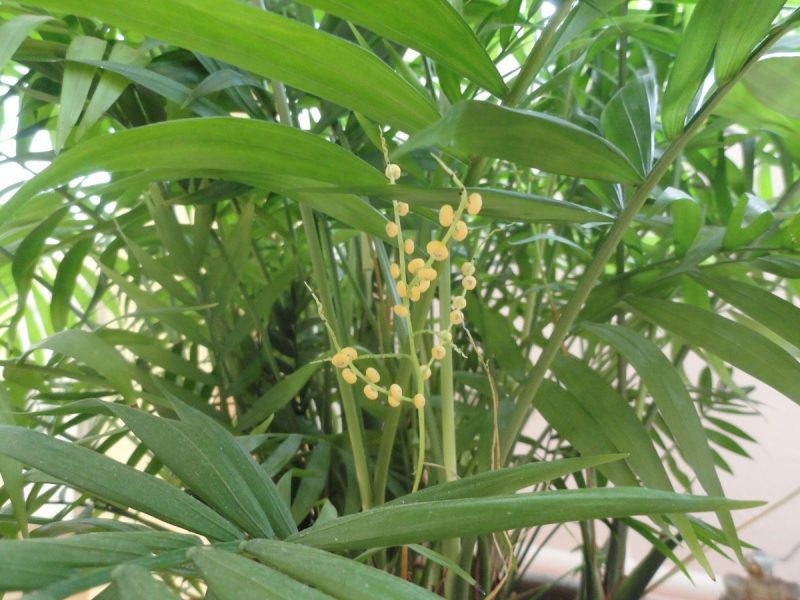
In nature, Hamedorea is accustomed to managing a small amount of nutrients, but enclosed in a limited volume of the pot requires regular fertilizing with fertilizers intended for decorative deciduous plants or, even better, for palm trees. Spend them with a frequency of once every 2 weeks the entire season of active vegetation. Overfed plants are easy prey for diseases and pests, so the concentration of the fertilizer solution is halved against the norm. In winter, plants are fed once a month, in good condition they can do without fertilizer.
Pruning
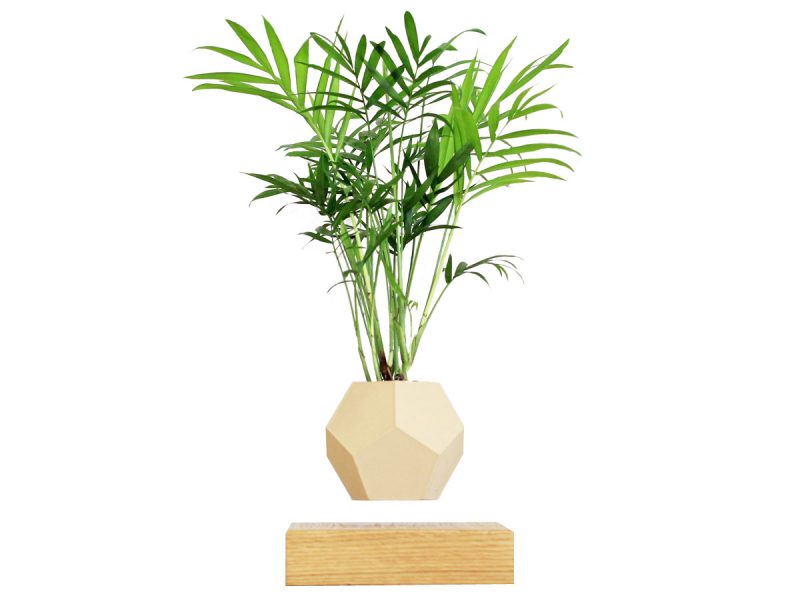
Plants do not need special forming pruning. Dry leaves are cut to healthy tissue with a sterilized instrument, sprinkling damage with cinnamon, crushed charcoal or moistening with fungicide.
Landing and transplanting
Only plants brought from the store need an emergency transplant. The transport soil in which they are located requires replacement. For the remaining palm trees, this is a planned event, annual for young plants. The rest require a new pot if they have already braided the roots of the entire earthen lump. It is better not to disturb adult plants with a transplant; it is enough to replace the topsoil annually with a new substrate.
When transplanting, choose a new pot a little more than the previous one. Drainage should be a quarter of its height.
Hamedorea is transplanted only by transshipment.
They try not to shake off the old earth from the roots, much less to destroy the earthen lump. The only thing that is permissible for a florist to transplant this palm is to carefully prune the damaged roots, if any. Sections must be sprinkled with crushed coal.
Propagation Features
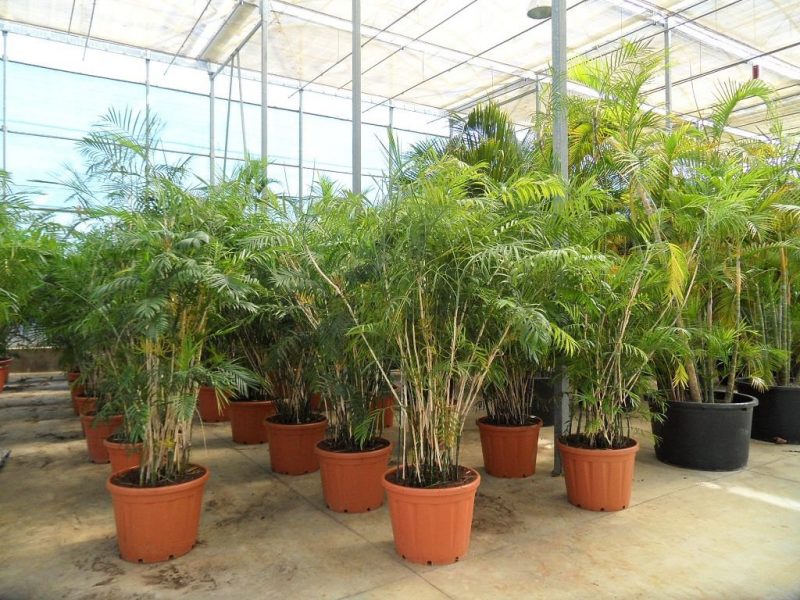
Hamedorea can reproduce both by seed and vegetatively. Her seeds are rapidly losing germination. Six months after harvest, only a third of the plants can grow. If you are lucky enough to get your seeds, which is rarely possible in room culture, you need to sow them right away by removing the flesh and soaking them for a week in water with a constant temperature of about 30 degrees, you can dissolve the Zircon immunostimulator in it. Seeds require scarification - damage to the hard shell; when planting, the damaged area should be at the bottom. The seeds are laid out in separate pots filled with a mixture of peat and sand superficially, not falling asleep with soil, but pressing them 1 cm. A plastic bag is put on each cup.

Germination conditions:
- humidity - 100%;
- always wet soil;
- temperature from 30 to 32 degrees, both air and soil;
- airing daily for several minutes.
Sometimes seedlings have to wait up to a year. As soon as the first leaf reaches a length of 4 cm, the plant needs a transplant into a new pot with a nutrient mixture of 2 parts of turfy land and sand and 1 part of humus and leafy land. After another 4 months, the palm tree is transplanted again, now in the soil intended for adult plants.
When propagating by dividing the bush, there is always a chance that the plant will not take root, since the bushes cannot be divided without exposing the root system, and the chamedorea does not like this very much.

But if you still want to get new plants by the division method, you need to do the following:
- it is more convenient to combine division with transplantation, conducting it in early spring;
- they take a palm tree out of the pot, completely shake off the ground, the roots are washed;
- remove all inferior roots: dried, rotten, they need to be cut to a healthy part;
- the palm trees are taken apart into separate plants; if a stem has no roots, then its chances of survival are zero;
- 4 to 5 layers are planted in each pot;
- care for them is the same as usual, but more thorough, the temperature for young plantings needs to be elevated - about 30 degrees, and air humidity at least 85%, they need to be sprayed at least 3 times a day.
If after a month and a half the plant did not die, the next transplant can be done no earlier than six months later.
Plant diseases and pests
If the plant is healthy and properly looked after, there are no problems. Too dry air is not only harmful to the palm, it can provoke the growth of spider mite colonies. In addition to it, scale insects and mealybugs can settle. A good preventive measure against pests is a regular warm shower with a soap-washed leaf. If pests continue to multiply, you will have to apply insecticide and insecticide treatment. Spend it at least 2 times with an interval of a week.
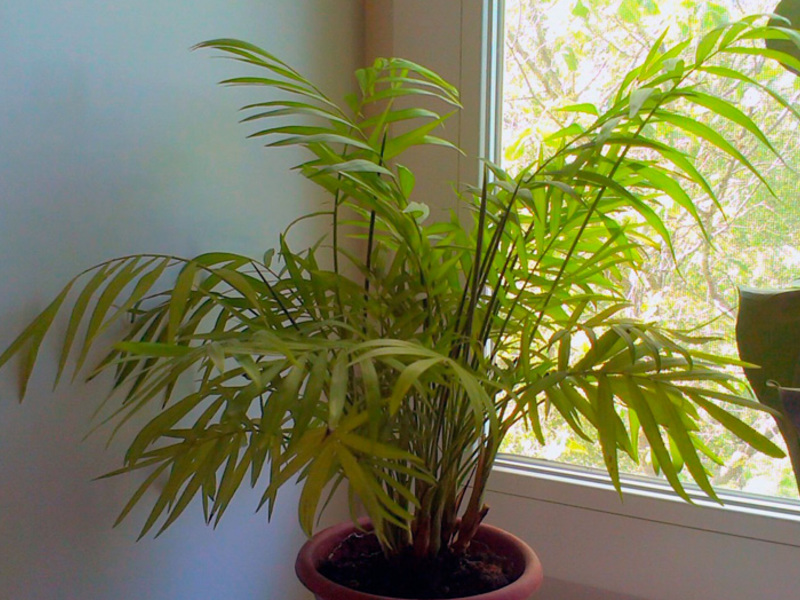
Various rot have a fungal nature and develop rapidly with excessive watering of the plant. They are fought with fungicides.
Why does chamedorrhea dry, leaves turn yellow?
The cause of the disease state of the plant is improper care. If the leaves turn yellow after transplanting, this is a temporary phenomenon. The lower leaves of the palm tree turn yellow and die - a natural process of changing the leaf apparatus.
If the leaves dry in bulk - the air has low humidity, if only the tips dry - you need to reduce watering. The same measures are taken if the plant looks sluggish, and the leaves turn black and die. It will be useful to check the roots for rot.
Dry spots of brown color - traces of sunburn, you need to adjust the illumination.
Palm trees are very fond of cats. The plant is protected by spraying with lemon juice. You can put a few lemon peels in the pot, which changes over time.












